
Durham's Chapel School, also known as Durham's Chapel Rosenwald School, is a former school for African-American children located in Gallatin, Sumner County, Tennessee, that is listed on the National Register of Historic Places.
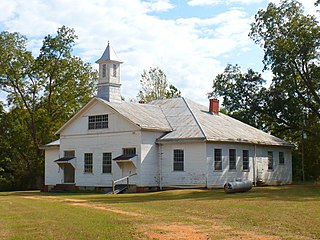
Prairie Mission, also known as the Prairie Mission School and Prairie Institute, was a historic African American school in the community of Prairie, Alabama. The school is the only survivor of the six original Presbyterian mission schools that once operated in Wilcox County. It was placed on the Alabama Register of Landmarks and Heritage on July 22, 1991 and subsequently on the National Register of Historic Places on October 29, 2001, due its significance to African American history.

The Vardy Community School was a Presbyterian mission school established in the Vardy community of Hancock County, Tennessee, United States, in the late-19th and early-20th centuries. At the time of its founding, the school was the only institution providing primary education to children of the multi-racial Melungeon communities, who lived in the remote mountainous areas along the Tennessee-Virginia border.
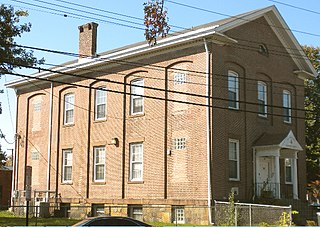
The Goffe Street Special School for Colored Children is an important landmark of African-American history at 106 Goffe Street in New Haven, Connecticut. The building, also known as Prince Hall Grand Lodge of Masons, was added to the National Register of Historic Places in 1979.

The Great Falls Grange Hall and Forestville School are two historic buildings that served as a Grange meeting hall and as a school located in Great Falls, Fairfax County, Virginia. The Forestville School was built in 1889 as a one-room school, and expanded in 1911 with the appendage of the Floris School. It is an "L"-shaped wood-frame structure covered in weatherboards and topped by a standing-seam metal cross-gable roof. After closing as a school in 1922, it served as a residence and then as the Great Falls Post Office from 1959 until 1982. The Great Falls Grange Hall was built in 1929, and is a 1 1/2-story brick building with a gable front. It features a front porch supported by concrete pillars in the American Craftsman style. Both buildings are owned by the Fairfax County Park Authority.
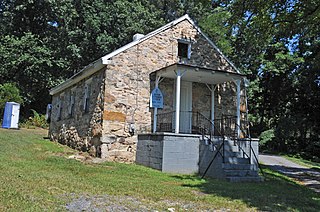
Mt. Pleasant School, now known as Mt. Olive Methodist Church, is a historic one-room school building located near Gerrardstown, Berkeley County, West Virginia. It was built about 1897 and is a one-story, gable roofed vernacular building. It measures approximately 24 feet wide and 39 feet deep. The exterior is finished in native random ashlar limestone. It is built into the slope of the hillside, and features a raised front porch. The school was built for African American children. It ceased use as a school in 1939 and began use as a church in 1942.

Matthew Whaley School is a public elementary school located in Williamsburg, Virginia, occupying a historic school building. It is within the Williamsburg-James City County Public Schools.

The Goose Creek Meeting House Complex is a Quaker worship center, with an original 1765 Meeting House, an 1817 meeting house, a burying ground, and the Oakdale schoolhouse in the village of Lincoln, Virginia. The complex is on the site of the original log meeting house, built about 1750. The 1765 meeting house is a one-story stone building, and was converted to a residence after the construction of the 1817 meeting house.
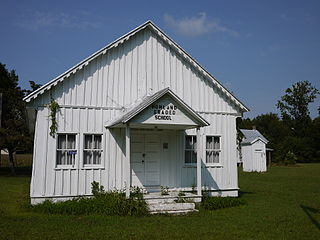
The Howland Chapel School is a historic school building for African-American students located near Heathsville, Northumberland County, Virginia. It was built in 1867, and is a one-story, gable fronted frame building measuring approximately 26 feet by 40 feet. It features board-and-batten siding and distinctive bargeboards with dentil soffits. The interior has a single room divided by a later central partition formed by sliding, removable doors. The building is a rare, little-altered Reconstruction-era schoolhouse built to serve the children of former slaves. Its construction was funded by New York educator, reformer and philanthropist Emily Howland (1827-1929), for whom the building is named. It was used as a schoolhouse until 1958, and serves as a museum, community center and adult-education facility.

The Second Union School is a historic Rosenwald school building for African-American children located near Fife, in western Goochland County, Virginia. It was built in 1918, as a two-teacher school, near Second Union Baptist Church, which had been founded in 1865 as an independent black congregation.

The Eddie Mae Herron Center & Museum is a historic community building at 1708 Archer Street in Pocahontas, Arkansas. Originally built as an African Methodist Episcopal Church and known as St. Mary's AME Church, it is a small one-room wood-frame structure, with a gable roof and novelty siding. A flat-roof addition expands the building to the right. The main facade has two entrances, each sheltered by a small gable-roofed hood. The building was built in 1918, to provide facilities for a church and school to the small African-American community in Pocahontas. It served as a church for thirty years, and as a school known as Pocahontas Colored School for fifty, and was later adapted for other uses, most recently as a museum and community center.

The Evergreen Congregational Church and School is a historic church and school at 497 Meridian Road in Beachton, Georgia. It is notable for its architecture, for its association with social history of the area, and for its association with civil rights leader Andrew Young, who served as its pastor from 1957 to 1959. It was added to the National Register of Historic Places in 2002.

Mt. Sidney School is a historic public school building located at Mount Sidney, Augusta County, Virginia. the original portion was built in 1912, and is the front gable-roofed, two-story block with an I-house plan consisting of two rooms and a central hallway on each floor. It features a central cross gable, one-story, three-bay porch. A four-room brick addition was built in 1921 and a gymnasium added in 1935. The school closed in 1967, and was subsequently remodeled into apartments.
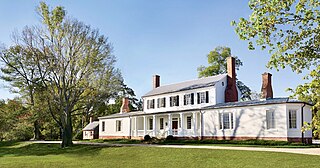
Gaymont, or Gay Mont, is a historic home located at Port Royal, Caroline County, Virginia. Originally called "Rose Hill", the central section of the house was built about 1790 by John Hipkins as a two-story frame structure with a gable roof and two exterior end chimneys. His grandson and heir, John Hipkins Bernard, renamed the house in honor of his wife, Jane Gay Bolling Robertson, a descendant of Pocahontas. It was enlarged in 1819 with the addition of flanking one-story stuccoed brick wings and a one-story colonnade of stuccoed brick Tuscan columns. In 1834 a one-story octagonal music room was added and in 1839 an octagonal library and office at the ends of each wing. Except for a brief 18-month change in ownership in 1958–1959, the house remained in the Bernard-Robb family until 2007 at which time it transferred to the Association for the Preservation of Virginia Antiquities. A family cemetery with almost 40 graves is set just to the north of the house along the forest edge.

Josephine City School is a historic school building for African-American children located at Berryville, Clarke County, Virginia. It was built about 1882, and is a rectangular, one-story, frame building with a gable roof and a four-bay side gable entrance facade. The school measures approximately 40 feet long and 30 feet wide. It is part of a school complex for African American children that included the Josephine City School; the 1930 brick Clarke County Training School; and a 1941 frame building that was constructed as additional agriculture classrooms. It was used as an elementary school until 1930, when it was moved a short distance from its original location, and used as the Clarke County Training School's home economics and agriculture classrooms. It was used for classrooms until 1971, when it was turned into storage space, after which it was converted into low/moderate-income elderly housing.

Number 18 School in Marshall is a historic one-room school located at Marshall, Fauquier County, Virginia. It was built about 1887, and is a rectangular frame building, covered with weatherboard, and resting on a stone foundation, with a metal gable roof with a centrally located brick stove flue. Atop the roof is a reconstructed cupola. It is the only surviving unimpaired one-room schoolhouse in Fauquier County. It was originally constructed for white students, then from the fall of 1910 to 1964, a school for African-American children.

Hill Grove School is a historic school for African American children located at Hurt, Pittsylvania County, Virginia. It was built in 1915, and is a small, simple single-story, weatherboarded, light-frame building on a fieldstone foundation, with a low-pitched side-gable roof. It features a single-bay, tin-covered, shed roof porch supported by two-by-four lumber over the entrance. The school closed in the early 1960s.

Longs Chapel, also known as Old Athens Church and Athens Colored School, is a historic Church of the United Brethren in Christ church and cemetery located at Zenda near Harrisonburg, Rockingham County, Virginia. It was built about 1871, and is a small, one-story, frame structure with a standard gable-fronted nave form with weatherboard siding, metal roofing, stone foundation piers, a small belfry, and an apse added about 1900. It measures approximately 20 feet by 30 feet. The cemetery includes multiple grave depressions, fieldstone tombstones, and a number of professionally carved marble monuments. The church also housed a one-room school for African-American children where Harrisonburg educator Lucy F. Simms first taught beginning in the 1870s. The school at Zenda closed in 1925 and the last services at Longs Chapel were held in the late 1920s. The building was subsequently used as a hay barn. The last burial was in 1935.

Seebert Lane Colored School, also known as Pleasant Green School and Hillsboro School, is a historic one-room school for African-American students located at Seebert, Pocahontas County, West Virginia. It was built about 1898, and is a one-story, front-gable frame building. The rectangular plan building measures approximately 24 feet, 4 inches, by 40 feet, 4 inches. The building has a symmetrical facade, small porch supported by two simple, rounded columns, and a cupola. Also on the property is a contributing fuel shed. In 1921, the children of Seebert Lane Colored School were photo documented by Lewis W. Hine as part of his work with the National Child Labor Committee (NCLC). There is no reliable date for when the building stopped operating as a school, though it likely coincided with desegregation in 1954.

The Espanola Schoolhouse is a one-story; one-room rural school building that has survived from the Jim Crow racial segregation-era. It is the last standing one-room schoolhouse in Flagler County. It is located at 98 Knox Jones Avenue, Bunnell, Florida 32110.
























